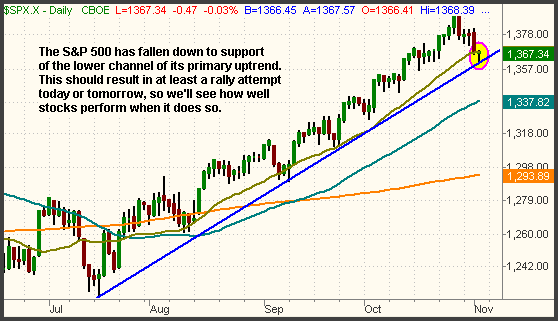How I’m playing the Internet sector
A weak close on Wednesday led to an
opening gap down yesterday morning, but stocks filled the gap in the
first two hours of trading. The major indices then traded in a tight, sideways
range before finishing the session flat overall. The S&P 500 and Nasdaq
Composite both were unchanged, as the Dow Jones Industrial Average edged 0.1%
lower. It was the Dow’s fifth consecutive session of losses, though the index
has fallen only 1.2% off its high. Small-cap stocks, which usually produce more
extreme moves than the S&P and Nasdaq in both directions, showed relative
weakness. The Russell 2000 Index lost 0.3%, while the S&P Midcap 400 declined
0.1%.
Turnover tapered off slightly yesterday, as total volume in
the NYSE came in 7% lighter than the previous day’s level. Volume in the Nasdaq
similarly declined by 4%. Since the major indices were flat, not much can be
inferred by the lighter volume. A look beneath the surface shows that market
internals were only marginally negative yesterday as well. In the NYSE,
declining volume exceeded advancing volume by only 1.2 to 1. The Nasdaq ratio
was negative by just under 3 to 2.
One sector that has begun showing relative strength and
positive money flow is the Internet Index ($GIN). Throughout most of October,
the $GIN consolidated in a narrow range, just below resistance of its 200-day
moving average. On October 24, the index broke out above its 200-day MA and the
high of its range, then trended higher over the next several days. Since the
broad market has been in correction mode since the October 27 selloff, spotting
relative strength within the sectors is relatively simple. We merely look for
those sectors which either have dropped a lesser percentage than the S&P and
Nasdaq. Even better are sectors that advanced while the major indices declined.
The $GIN Index is one such sector:

Since its October 26 peak, the Nasdaq Composite has fallen
1.9% and the S&P 500 has lost 1.6%. The $GIN Index, however, has gained
0.8% during the same period. When a sector does not fall when the broad market
does, it is usually the first to surge higher when the overall market reverses
back up. Further, sectors with relative strength are the last to fall if
downward pressure on the broad market continues. These are the two basic
premises for trading sectors with relative strength or weakness to the major
indices. When the stock market finishes its correction and attempts to rally, we
expect the Internet stocks to be among the top gainers, but make sure you are
buy the ETF with the most relative strength to the sector index itself. Although
it is the most well-known of the Internet ETFs, the Internet HOLDR
(
HHH |
Quote |
Chart |
News |
PowerRating) has
been showing relative weakness to the $GIN. The simple reason is that sector
leader Google
(
GOOG |
Quote |
Chart |
News |
PowerRating) is not represented within HHH. As with all the HOLDRS,
the underlying components have not changed since their inception years ago
(other than through acquisitions). Notice how HHH is still trading below its
prior high from July, but the $GIN Index is above its corresponding high. HHH is
also below its 200-day MA, whereas the $GIN broke out above its a few weeks ago:

Unfortunately, there are not a lot of alternative ETFs that
are directly correlated to the Internet sector. If looking for one, your best
bet may be the First Trust DJ Internet
(
FDN |
Quote |
Chart |
News |
PowerRating), a little known Internet ETF
that does have representation by Google.
After moving down to support of its 20-day moving average on
Wednesday, the S&P 500 closed yesterday right on support of the lower channel of
its primary uptrend:

Since the current uptrend began, the vicinity of the 20-day
moving average has acted as support that has enabled every correction in the S&P
to reverse back to new highs. Obviously, we don’t know if that will happen
again, but we should at least see a rally attempt in the S&P today. The breadth
and volume behind such a rally attempt will give us clues as to whether the
index has enough juice left to set new highs, or whether the bounce is something
we should be selling into. Because of the poor performance of leading stocks
that we discussed yesterday, we think the latter may be the case, but we’ll have
more confirmation after we see how the S&P acts here at trendline support.
Open ETF positions:
Long GLD and OIH, short SMH (regular subscribers to
The Wagner Daily receive detailed stop and target prices on open
positions and detailed setup information on new ETF trade entry prices. Intraday
e-mail alerts are also sent as needed.)
Deron Wagner is the head trader of
Morpheus Capital Hedge Fund and founder of Morpheus Trading Group (morpheustrading.com),
which he launched in 2001. Wagner appears on his best-selling video, Sector
Trading Strategies (Marketplace Books, June 2002), and is co-author of both The
Long-Term Day Trader (Career Press, April 2000) and The After-Hours Trader
(McGraw Hill, August 2000). Past television appearances include CNBC, ABC, and
Yahoo! FinanceVision. He is also a frequent guest speaker at various trading and
financial conferences around the world. For a free trial to the full version of
The Wagner Daily or to learn about Deron’s other services, visit
morpheustrading.com
or send an e-mail to
deron@morpheustrading.com .
